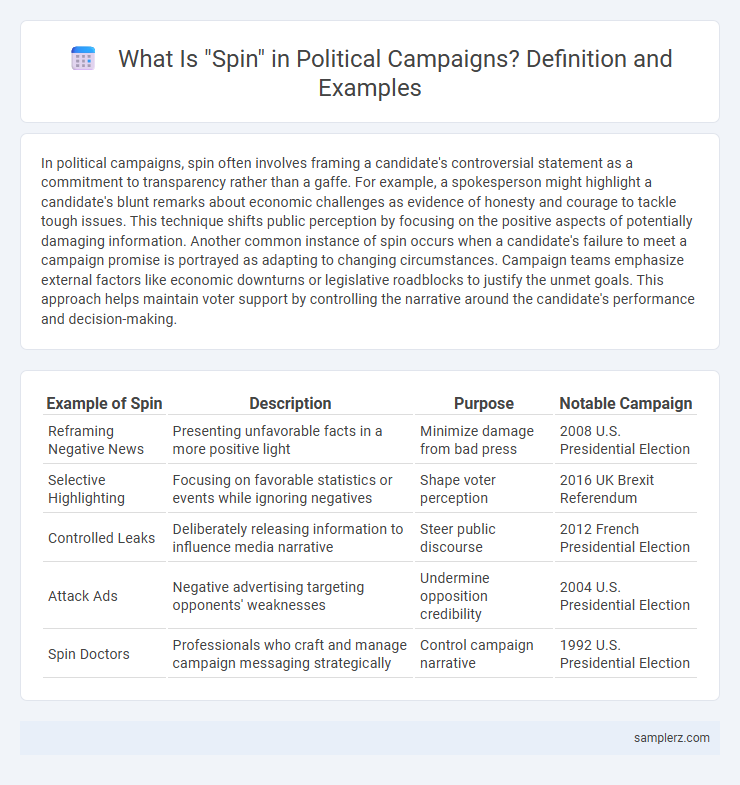In political campaigns, spin often involves framing a candidate's controversial statement as a commitment to transparency rather than a gaffe. For example, a spokesperson might highlight a candidate's blunt remarks about economic challenges as evidence of honesty and courage to tackle tough issues. This technique shifts public perception by focusing on the positive aspects of potentially damaging information. Another common instance of spin occurs when a candidate's failure to meet a campaign promise is portrayed as adapting to changing circumstances. Campaign teams emphasize external factors like economic downturns or legislative roadblocks to justify the unmet goals. This approach helps maintain voter support by controlling the narrative around the candidate's performance and decision-making.
Table of Comparison
| Example of Spin | Description | Purpose | Notable Campaign |
|---|---|---|---|
| Reframing Negative News | Presenting unfavorable facts in a more positive light | Minimize damage from bad press | 2008 U.S. Presidential Election |
| Selective Highlighting | Focusing on favorable statistics or events while ignoring negatives | Shape voter perception | 2016 UK Brexit Referendum |
| Controlled Leaks | Deliberately releasing information to influence media narrative | Steer public discourse | 2012 French Presidential Election |
| Attack Ads | Negative advertising targeting opponents' weaknesses | Undermine opposition credibility | 2004 U.S. Presidential Election |
| Spin Doctors | Professionals who craft and manage campaign messaging strategically | Control campaign narrative | 1992 U.S. Presidential Election |
How Campaigns Use Spin to Shape Public Perception
Campaigns strategically deploy spin by selectively framing information to highlight strengths and downplay weaknesses, often using persuasive messaging and controlled media appearances. By crafting compelling narratives around candidate achievements or opponent controversies, campaigns manipulate public perception to gain voter support. This tactic leverages emotional appeals and repetition to influence opinions and dominate the political discourse.
Classic Examples of Political Spin in Election Campaigns
During the 1984 U.S. presidential campaign, Ronald Reagan's team masterfully used spin by framing economic recovery as a direct result of his policies, despite mixed data on income inequality and unemployment rates. In the 1992 election, Bill Clinton's "It's the economy, stupid" slogan effectively redirected public attention from personal scandals to economic issues, aiding his campaign's message. The 2008 Obama campaign's narrative of "Change" capitalized on widespread dissatisfaction with the status quo, spinning hope and optimism to counter fears stemming from the economic crisis.
The Role of Media in Amplifying Campaign Spin
Campaign spin often relies on media outlets to amplify strategic messaging, shaping public perception by emphasizing selective facts or emotionally charged narratives. Media coverage that prioritizes sensational headlines or soundbites can distort complex policy issues, steering voter opinions through repetitive framing and agenda-setting. This symbiotic relationship between campaigns and media outlets amplifies spin by maximizing exposure and targeting key demographics effectively.
Famous Spin Tactics Used by Political Strategists
Famous spin tactics used by political strategists include rebranding negative news as positive achievements, such as emphasizing economic growth despite rising unemployment rates. Strategists often deploy selective messaging to divert attention from scandals by highlighting unrelated policy successes, effectively shaping public perception. Another common method involves framing opponents' statements out of context to create misleading narratives that erode voter confidence.
Case Studies: Spin in Presidential Election Campaigns
In the 2008 U.S. presidential election, Barack Obama's campaign effectively used spin by framing the economic crisis as a direct consequence of Republican policies, thereby positioning himself as the candidate of change and hope. Conversely, John McCain's team attempted to spin Obama's experience as insufficient by highlighting his relatively short tenure in the Senate. These strategic narratives significantly influenced public perception and media coverage during the election.
The Impact of Spin on Voter Behavior
Spin in political campaigns often reshapes voter perceptions by framing controversial policies as progressive achievements, influencing undecided voters through emotional appeals and selective facts. Strategic messaging can divert attention from negative issues, boosting a candidate's image despite underlying shortcomings. This manipulation of information significantly alters voter behavior, increasing support for candidates who effectively control the narrative.
Comparing Positive and Negative Spin in Campaign Messaging
Positive spin in campaign messaging highlights candidates' achievements, policy successes, and future plans, creating an optimistic and hopeful image for voters. Negative spin emphasizes opponents' flaws, mistakes, or controversies, aiming to diminish their credibility and sway public opinion through fear or distrust. Campaign strategists balance these approaches to maximize voter engagement while managing the candidate's overall reputation.
Real-World Examples of Fact Distortion in Politics
During the 2016 U.S. presidential campaign, several candidates employed spin tactics that distorted facts to sway voter opinions, such as exaggerating economic achievements or misrepresenting opponents' policies. For instance, claims about job creation were often inflated by manipulating employment statistics to portray stronger economic growth. These distortions highlight how political campaigns use selective data presentation to influence public perception and voter behavior.
Spin Doctors: Key Figures Behind Campaign Messaging
Spin doctors like James Carville and Lynton Crosby shape public perception by strategically framing political narratives to favor their candidates. Their expertise in message management involves reinterpreting negative events and emphasizing positive angles to control media coverage. Effective spin tactics often pivot on timely soundbites and targeted social media campaigns that resonate with specific voter demographics.
Strategies to Recognize and Counter Political Spin
Political spin often involves selectively presenting facts to manipulate public perception, such as emphasizing economic growth while downplaying rising unemployment rates. Recognizing spin requires critical evaluation of sources, fact-checking statements, and comparing opposing narratives for inconsistencies. Countering spin effectively includes promoting transparency, encouraging media literacy, and supporting independent journalism to foster informed voter decisions.

example of spin in campaign Infographic
 samplerz.com
samplerz.com